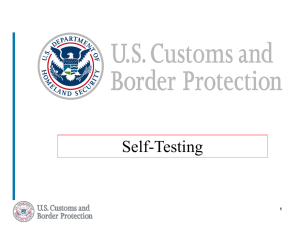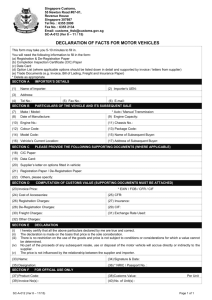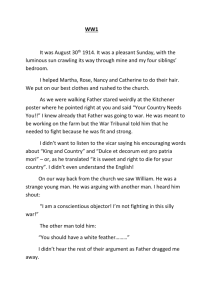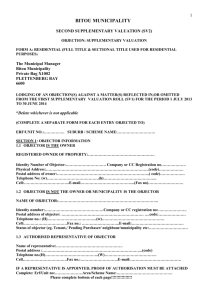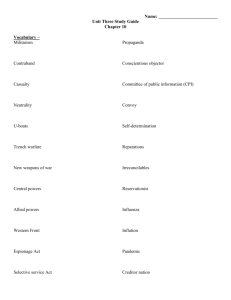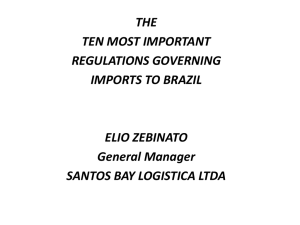Schedule 5 EM RTF
advertisement
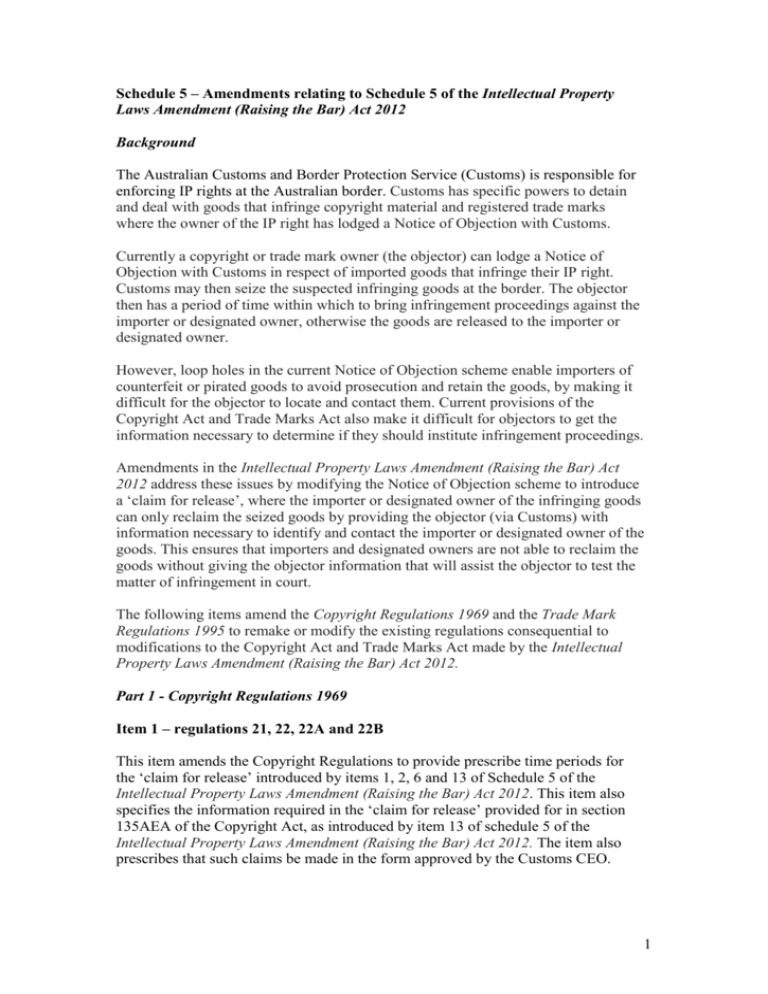
Schedule 5 – Amendments relating to Schedule 5 of the Intellectual Property Laws Amendment (Raising the Bar) Act 2012 Background The Australian Customs and Border Protection Service (Customs) is responsible for enforcing IP rights at the Australian border. Customs has specific powers to detain and deal with goods that infringe copyright material and registered trade marks where the owner of the IP right has lodged a Notice of Objection with Customs. Currently a copyright or trade mark owner (the objector) can lodge a Notice of Objection with Customs in respect of imported goods that infringe their IP right. Customs may then seize the suspected infringing goods at the border. The objector then has a period of time within which to bring infringement proceedings against the importer or designated owner, otherwise the goods are released to the importer or designated owner. However, loop holes in the current Notice of Objection scheme enable importers of counterfeit or pirated goods to avoid prosecution and retain the goods, by making it difficult for the objector to locate and contact them. Current provisions of the Copyright Act and Trade Marks Act also make it difficult for objectors to get the information necessary to determine if they should institute infringement proceedings. Amendments in the Intellectual Property Laws Amendment (Raising the Bar) Act 2012 address these issues by modifying the Notice of Objection scheme to introduce a ‘claim for release’, where the importer or designated owner of the infringing goods can only reclaim the seized goods by providing the objector (via Customs) with information necessary to identify and contact the importer or designated owner of the goods. This ensures that importers and designated owners are not able to reclaim the goods without giving the objector information that will assist the objector to test the matter of infringement in court. The following items amend the Copyright Regulations 1969 and the Trade Mark Regulations 1995 to remake or modify the existing regulations consequential to modifications to the Copyright Act and Trade Marks Act made by the Intellectual Property Laws Amendment (Raising the Bar) Act 2012. Part 1 - Copyright Regulations 1969 Item 1 – regulations 21, 22, 22A and 22B This item amends the Copyright Regulations to provide prescribe time periods for the ‘claim for release’ introduced by items 1, 2, 6 and 13 of Schedule 5 of the Intellectual Property Laws Amendment (Raising the Bar) Act 2012. This item also specifies the information required in the ‘claim for release’ provided for in section 135AEA of the Copyright Act, as introduced by item 13 of schedule 5 of the Intellectual Property Laws Amendment (Raising the Bar) Act 2012. The item also prescribes that such claims be made in the form approved by the Customs CEO. 1 Regulation 21 is amended to clarify that a person must comply with a direction of the Customs CEO to provide information or evidence under paragraph 135(8)(c) of the Copyright Act. Also the note to regulation 21 provides a revised definition for the term CEO by reference to section 134B of the Copyright Act. This definition of CEO is necessary for the operation of regulations 21 and 22B. Currently Customs is required to hold seized goods for a ‘retention period’ while the objector determines whether to institute infringement proceedings against the importer. The period within which the objector must commence proceedings is known as the ‘action period’. An importer can frustrate the objector’s efforts to commence proceeding within the ‘action period’ by making it difficult for the objector to identify and contact them, or serve the importer with court documents, within this period. If the importer is successful in frustrating the objector’s efforts and proceedings are not commenced, Customs must release the goods to the importer at the end of the ‘retention period’. The Intellectual Property Laws Amendment (Raising the Bar) Act 2012 addresses this problem by introducing a ‘claim for release’ into the Notice of Objection scheme. An importer who wishes the return of their goods will be required to lodge a claim for release, which includes the importer’s name and address details, before Customs will release the seized goods to them. This item prescribes the ‘claim’ period’, which is the period during which the importer must lodge a claim for return, and the ‘action period’ which is the period during with the objector must commence infringement proceedings. New regulation 22A prescribes the ‘claim period’ as the period of 10 working days after notice of seizure of the goods is given to the importer. While new regulation 22 prescribes the ‘action period’ as the period of 10 working days after a notice of a claim for release of the goods is given to the objector. Currently an objector is often unable to contact an importer of seized goods within the time limit for instituting infringement proceedings due to a lack of contact and address details for the importer. Also the objector is generally only able to obtain information about the foreign exporter or consignor (the person who provided the copies to the importer) by court order, which can be expensive and time consuming. The Intellectual Property Laws Amendment (Raising the Bar) Act 2012 amends the Copyright Act to introduce the ‘claim for release’ into the Notice of Objection scheme. The claim for release requires an importer (who wants the release of the seized copies) to provide identifying information, as prescribed in the regulations, to Customs within the ‘claim period’. The Customs CEO would then provide this information to the objector. This item also inserts new regulation 22B which prescribe the requirements for the ‘claim for release’. Subregulation 22B(1) prescribes that the claim is in writing in a form approved by the Customs CEO. Subregulation 22B(2) requires that the claim include the name and address of the importer. If the importer does not have a place of residence in Australia, the claim must also include the name and address of the importer’s agent in Australia or of any person that made arrangements on behalf of 2 the importer for the goods to be imported. The phrasing of sub-regulation 22B(c) is intended to ensure that contact and identifying details of any foreign exporter, consignor or other party involved in the importation of the seized copies are included in the information provided to the Customs CEO and ultimately the objector. Providing the objector with details of all parties associated with an importation will allow copyright owners to address infringement at its source and identify repeat offenders. Part 2 - Trade Marks Regulations 1995 Item 2 – regulation 13.1A and 13.1 to 13.6 This item amends the Trade Marks Regulations to restructure existing regulations for the Notice of Objection scheme and to prescribe time periods and requirements for the ‘claim for release’ introduced by items 18 to 22 of schedule 5 of the Intellectual Property Laws Amendment (Raising the Bar) Act 2012. New regulation 13.1A clarifies that references to the Customs CEO should be read as being modified to account for differences in border protection laws between Australia, Norfolk Island, Christmas Island and the Cocos (Keeling) Islands. Currently Customs is required to hold seized goods for an ‘action period’ while the objector determines whether to institute infringement proceedings against the designated owner of the imported goods. A designated owner can frustrate the objector’s efforts to commence infringement proceedings by making it difficult for the objector to contact them within the ‘action period’. If the designated owner is successful in frustrating the objector’s efforts and proceedings are not commenced Customs must release the goods to the designated owner at the end of the ‘action period’. Also the objector is generally only able to obtain information about the foreign exporter or consignor (the person who provided the goods to the designated owner) by court order, which can be expensive and time consuming. The Intellectual Property Laws Amendment (Raising the Bar) Act 2012 amends the Trade Marks Act to introduce the ‘claim for release’, into the Notice of Objection scheme, which requires the designated owner (who wants the release of seized goods) to provide identifying information to Customs, as prescribed by the regulations, prior to the objector being required to institute proceedings, within a prescribed period. This item prescribes the ‘action’ and ‘claim’ periods and requirements for the Notice of Objection and the claim for release. New subregulations 13.1 and 13.2 prescribe the ‘action’ and ‘claim’ periods. The ‘action period’ is 10 working days after a notice of a claim for release of the goods is given to the objector. The ‘claim period’ is 10 days after notice of seizure of the goods is given to the designated owner. New subregulations 13.3 and 13.4 prescribe the requirements for the Notice of Objection. These requirements are currently prescribed in subregulations 13.1 and 13.2 and re-making of the provisions in 13.3 and 13.4 does not effect their operation. 3 New subregulation 13.5 prescribes the requirements for the purpose of new subsection 136(3) of the Trade Marks Act. Subregulation 13.5(1) prescribes that the claim for release is in writing and in a form approved by the Customs CEO. Subregulation 13.5(2) requires that the claim for release include the name and address of the designated owner. If the designated owner does not have a place of residence in Australia, the claim must also include the name and address of the owner’s agent in Australia or of any person that made arrangements on behalf of the owner for the goods to be imported. The phrasing of sub-regulation 13.5(2)(d) is intended to ensure that contact and identifying details of any foreign exporter, consignor or other party involved in the importation of the seized goods are included in the information provided to the Customs CEO and ultimately the objector. Providing the objector with details of all parties associated with an importation will allow trademark owners to address infringement at its source and identify repeat offenders. Item 3 – regulations 13.7 to 13.10 This item amends the Trade Marks Regulations consequential to the changes made in item 2. Existing regulations 13.3 to 13.6 have been renumbered as regulations 13.7 to 13.10. Schedules 3, 4 & 5 These schedules and their items amend the Trade Marks Regulations to allow for modification of Part 13 of the Trade Marks Act. Currently schedules 3 to 5 of the Trade Marks Regulations set out provisions by which Part 13 of the Trade Marks Act is modified to account for differences in border protection laws between Australia, Norfolk Island, Christmas Island and the Cocos (Keeling) Islands. These schedules and their items amend each of the current schedules 3 to 5 of the Trade Marks Regulations to account for amendments the Trade Marks Act made by Schedule 5 of the Intellectual Property Laws Amendment (Raising the Bar) Act 2012. 4
